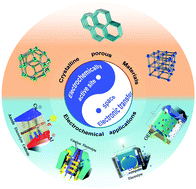Electrochemically active sites inside crystalline porous materials for energy storage and conversion
Abstract
The design and development of crystalline porous materials (CPMs), including metal–organic frameworks (MOFs) and covalent–organic frameworks (COFs), have been subjects of extensive study due to their regular crystalline lattices and well-defined pore structures. In recent times, an enormous amount of research effort has gone into using CPMs as sacrificial templates to fabricate electrochemically functional materials. The inherently electrochemically active sites inside CPMs are notably abundant and being explored with respect to electrochemical reactions. In this review, electrochemically active sites and the space around them (metal ions, ligands, crystal structures, pores, and morphologies) inside CPMs are the focus and recent progress in the fields of metal-ion batteries, metal–air batteries, water splitting, and other related electrochemical devices has been summarized. Overall, this review provides guidance on the preparation of electroactive CPMs via rational design and modulation of active sites such as redox-active metal clusters and organic ligands, and the space around the electrochemically active sites, and their applications in electrochemical energy storage and conversion systems.

- This article is part of the themed collection: Electrochemistry in Energy Storage and Conversion


 Please wait while we load your content...
Please wait while we load your content...